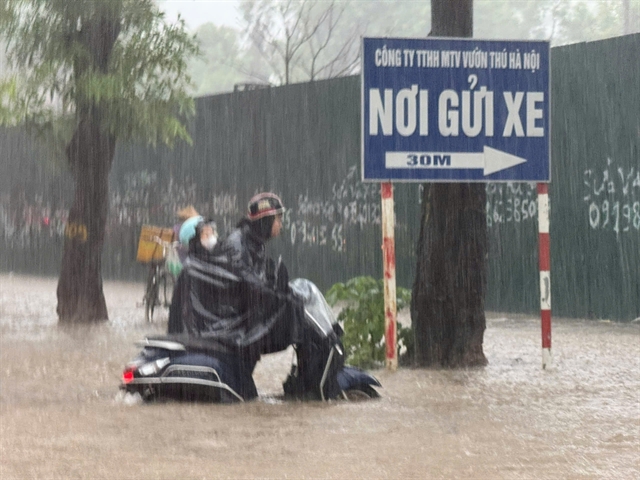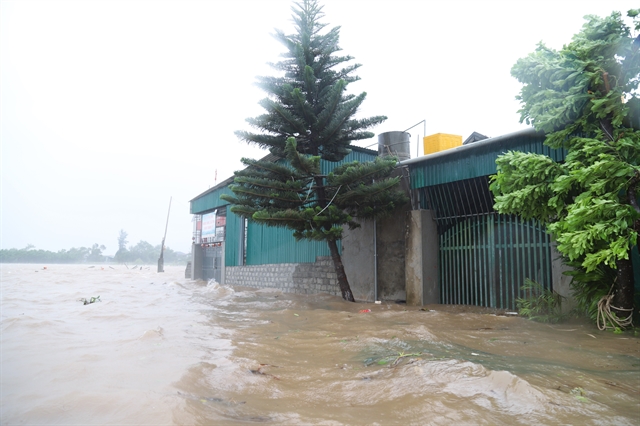 Environment
Environment

 |
| Heavy rains from the storm’s aftermath flood large parts of Hà Nội, leaving many vehicles stranded on deeply inundated streets. — VNA/VNS Photo |
HÀ NỘI — Typhoon Kajiki, designated in Việt Nam as Typhoon No.5, weakened into a tropical depression over central Laos on Tuesday after sweeping across northern and north-central Việt Nam with fierce winds and torrential rain.
According to the National Centre for Hydro-Meteorological Forecasting, the typhoon crossed into Laos early in the morning, carrying sustained winds of 50–61 km/h and gusts up to 88 km/h.
 |
| Heavy downpours from Monday night to Tuesday morning caused serious flooding across Hà Nội, disrupting traffic especially in the morning rush hour. — VNA/VNS Photo |
Before weakening, it lashed coastal and inland areas of Việt Nam with destructive gusts. At sea, strong winds were reported at Bạch Long Vĩ in Hải Phòng and Cô Tô in Quảng Ninh, where gusts reached levels 9 and 10 on the Beaufort scale (75-102km/h), respectively.
On Hòn Ngư Island in Nghệ An, winds strengthened to level 8 with gusts up to 11. Along the coast from Quảng Ninh to Thanh Hóa, winds of level 6–8 were observed, while in Nghệ An and Hà Tĩnh, gusts climbed as high as level 15.
 |
| The residential area near Lạch Vạn estuary in Ngọc Minh hamlet (Diễn Châu commune, Nghệ An Province) has been severely flooded due to rising sea due to Typhoon Kajiki. — VNA/VNS Photo |
Storm surges were recorded at 1.66m at Hòn Ngư, 1.01m at Sầm Sơn in Thanh Hóa, and 0.51m at Vũng Áng in Hà Tĩnh.
Heavy rains accompanied the system, with provinces from Thanh Hóa to Quảng Trị and the Red River Delta experiencing totals already exceeding 600mm in some locations.
Meteorologists forecast continued downpours through Tuesday, with most areas expected to receive 50–100mm, and isolated pockets potentially exceeding 200mm.
In upper and central Laos, rainfall of 100–250mm was expected through Wednesday, with some places predicted to surpass 500mm.
Authorities warned of heightened risks of flash floods, landslides and sudden inundations, particularly in mountainous and low-lying regions.
 |
| Several houses were damaged in Lý Thường Kiệt Ward, Ninh Bình Province from a tornado late August 25. — VNA/VNS Photo |
The typhoon’s destructive force was felt most dramatically on Monday evening when a brief but violent tornado struck the northern province of Ninh Bình.
The tornado cut across a two-kilometre stretch along National Highway 21 in Lý Thường Kiệt Ward, collapsing homes and toppling infrastructure.
Officials reported that more than 200 houses were damaged in Lý Thường Kiệt. In Kim Bảng Ward, 25 households suffered roof losses and structural damage to gates, fences and outbuildings.
An 88-year-old woman died when her house collapsed during the tornado. Local authorities worked overnight to help families repair damage, clear debris and secure shelters.
The national emergency response was extensive. The Ministry of National Defence mobilised more than 346,000 personnel and 8,200 vehicles, including five aircraft, to support storm relief.
With the military support, 43,861 people were evacuated to safe places across five provinces.
Authorities also confirmed that 23,275 fishing vessels with nearly 77,000 crew members had sought shelter in safe harbours, leaving only 32 vessels with 225 workers still at sea but operating in safe zones.
The General Staff of the People’s Army of Việt Nam issued an urgent directive late Monday night, instructing local military commands to remain on high alert, reinforce coordination with provincial authorities and prepare for rapid deployment in areas vulnerable to landslides, flash floods and large-scale inundation.
The Air Defence–Air Force Service and Division 18 were ordered to ready aircraft for potential search-and-rescue operations and relief transport. Viettel, the military-owned telecommunications group, was tasked with maintaining communication in areas cut off by floods and landslides to ensure connectivity. — VNS




